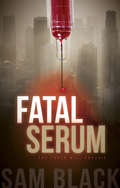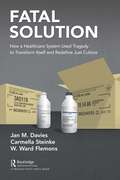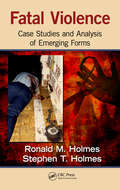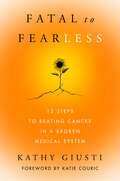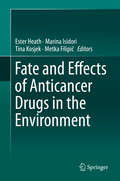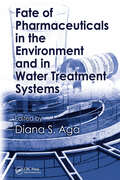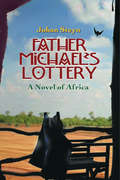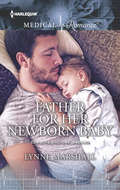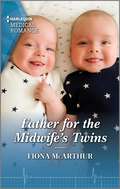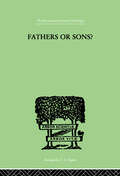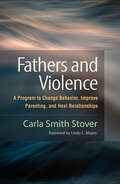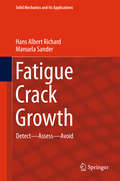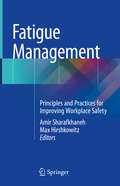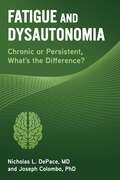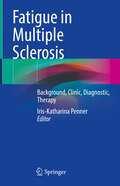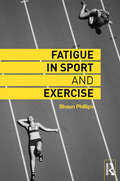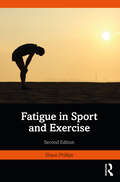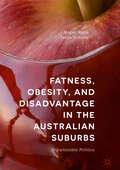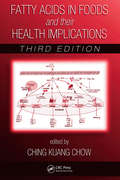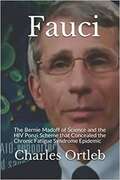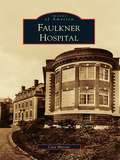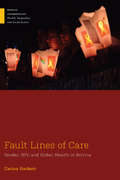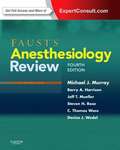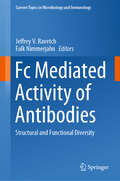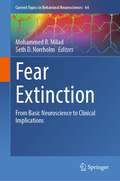- Table View
- List View
Fatal Serum: The Truth Will Prevail (Fatal Serum Ser.)
by Sam BlackFrom the author of Avengement comes a gripping thriller of big pharma, government corruption, and a defiant doctor&’s struggle for survival. Ten years ago, doctorate student Sam Abbot created two astounding serums. One could prevent contagious diseases while the other was capable of blocking the harmful effects of air pollution on human lungs. Both could change the world. Shocked to have his miraculous work turned down by big pharma, Sam gets help from a wealthy rogue benefactor to start his own company. But when the drug companies see their profits dropping, they use their influence with a shady US senator to take out the competition. Now, just as Sam is about to go on a well-earned vacation, his wife mysteriously disappears—and Sam is named the prime suspect. Desperate and on the run, Sam must finally confront the powers that have haunted his life if he or his wife are to survive.
Fatal Solution: How a Healthcare System Used Tragedy to Transform Itself and Redefine Just Culture
by Jan M. Davies, MSc, MD, FRCPC, FRAeS Carmella Steinke, RRT, BHS(RT), MPA W. Ward Flemons, MD, FRCPCOne box of chemicals mistaken for another. Ingredients intended to be life-sustaining are instead life-taking. Families in shock, healthcare providers reeling and fingers starting to point. A large healthcare system’s reputation hangs in the balance while decisions need to be made, quickly. More questions than answers. People have to be held accountable – does this mean they get fired? Should the media and therefore the public be informed? What are family members and the providers involved feeling? When the dust settles, will remaining patients be more safe or less safe? In this provocative true story of tragedy, the authors recount the journey travelled and what was learned by, at the time, Canada’s largest fully integrated health region. They weave this story together with the theory about why things fall apart and how to put them back together again. Building on the writings and wisdom of James Reason and other experts, the book explores new ways of thinking about Just Culture, and what this would mean for patients and family members, in addition to healthcare providers. With afterwords by two of the major players in this story, the authors make a compelling case that Just Culture is as much about fairness and healing as it is about supporting a safety culture.
Fatal Violence: Case Studies and Analysis of Emerging Forms
by Ronald M. Holmes Stephen T. HolmesFrom serial murderers to parents who kill, Fatal Violence: Case Studies and Analysis of Emerging Forms provides an insider‘s look at a phenomenon that has existed since the dawn of man and cuts across social/economic barriers and cultures. Offering a rare glimpse into the minds of predators and containing chilling details of motives and methods, th
Fatal to Fearless: 12 Steps to Beating Cancer in a Broken Medical System
by Kathy GiustiAn empowering, soul-baring personal account and guide from a two-time cancer survivor and healthcare disrupter that shows anyone how to deal with a frightening medical diagnosis in America today, providing the knowledge necessary to take ownership of personal wellbeing and maximize the chances for survival.More than twenty-five years ago, Kathryn Giusti was diagnosed with multiple myeloma at age thirty-seven and given three years to live. With a young child, a happy marriage, and a successful career, Giusti had too much to live for. An “impatient patient,” she overcame her fear and got to work, learning to advocate for her own care. This book is the result of all she’s learned about how to get the best outcome from America’s opaque and sometimes impossible-to-navigate healthcare system.Fatal to Fearless tells the story of how Giusti took on the system and turned it to her advantage not once but twice when she was diagnosed with breast cancer a few years ago. It is a crash course in surviving a grim diagnosis, organized around twelve simple steps, with practical tips for everything from how to build your healthcare team and learning which online sources to trust, to understanding the science and identifying which tests to ask for in the new genomic era and how to access the treatments and studies that could save your life.At its center is a gripping personal story that reveals difficult, yet honest truths about illness, family, friendship, marriage, and the business of medicine. Giusti lays bare her soul as she walks you through the steps for handling any diagnosis and includes insights from medicine’s top insiders on the frontlines of physical and emotional healing and care.Sick people deserve a fighting chance. Giusti’s mission to democratize medicine—and healthcare—has never been more imperative, or more urgent. Hopeful, wise, and packed with hard-won knowledge, this book gives you the concrete tools and inspiration to fear less and live more.
Fate and Effects of Anticancer Drugs in the Environment
by Ester Heath Marina Isidori Tina Kosjek Metka FilipičThe book provides current knowledge and research on the presence and effects of anticancer drug residues in the aqueous environment and covers all relevant aspects of the presence of these residues in wastewaters and natural aquatic systems, where numerous analogies between their pharmacokinetics and pharmacodynamics in humans and their effects in the environment can be drawn. This book comprises of 18 chapters and represents the combined work of leading scientists from different research institutions from across the globe. We present the state of the art in the field of anticancer drug residues in the aquatic environment while being cognizant of the many challenges that remain.
Fate of Pharmaceuticals in the Environment and in Water Treatment Systems
by Diana S. AgaThe detection of pharmaceutical residues remained elusive until instruments such as liquid chromatography and mass spectrometry became commonplace in environmental laboratories. The documentation of the occurrence of pharmaceutical residues and endocrine disrupting chemicals in water resources has raused questions about their long-term effects
Father Michael’s Lottery: A Novel of Africa
by Johan SteynA beleaguered doctor and his staff struggle to maintain a hospital in a remote, rural community on the front lines of the African AIDS epidemic in this inspirational and life-affirming novel. The hospital and its patients do battle against meddlesome superiors, find eccentric saviors from the village, and provide readers with an unflinching look at the human cost of ignorance and apathy. The good doctor's daily struggles for the people, land, and wildlife of Africa tell a story of humor, realism, and compassion.
Father for Her Newborn Baby (Cowboys, Doctors...Daddies #2)
by Lynne MarshallMother and baby make three... When famed cardiologist Cole Montgomery returns home for his brother's wedding, a medical emergency means he must stay and care for his father. He hires Dr. Lizzie Silva to help, but he doesn't expect her to be so beautiful...or to show up with a tiny daughter! Single mom Lizzie has had a hard life, but working alongside scrumptious Cole reminds her that romance does exist! She can see him falling for her little daughter...does she dare hope that this notorious bachelor might fall for her, too?
Father for the Midwife's Twins
by Fiona McArthurWhen a midwife is about to deliver her twins in the hospital elevator, a brooding and gorgeous obstetrician comes to her rescue…in more ways than one! Find out what happens in this heartwarming story by Fiona McArthur.Two babies. One houseguest…A forever family? Midwife Lisandra panics when the hospital elevator gets stuck—just as her water breaks! Luckily, she&’s trapped with obstetrician Malachi, who expertly cares for her. Having lost everything since her fiancé&’s death, she has nowhere to go, so Malachi offers her and her babies a temporary place to stay. But living with the brooding workaholic is less convenient when a spark ignites between them! Could her knight in shining armor also become a father for her twins?From Harlequin Medical: Life and love in the world of modern medicine.
Fathers Or Sons?: A STUDY IN SOCIAL PSYCHOLOGY
by Hopkins, PrynceFirst Published in 1999. Routledge is an imprint of Taylor & Francis, an informa company.
Fathers and Violence: A Program to Change Behavior, Improve Parenting, and Heal Relationships
by Carla Smith StoverThis highly accessible book presents a new approach to treating men who use violence against their partners and/or children. The Fathers for Change (F4C) program has a unique focus on fostering fathers' accountability and reflective functioning, and repairing father–child relationships. Grounded in theory and research, it addresses a key need for parents who want to stay together or coparent successfully in the aftermath of violence, while prioritizing all family members' safety. Clinicians learn how to implement each component of F4C, from assessment to individual-focused work to coparent and family sessions, if appropriate. Illustrative case vignettes are featured throughout. An appendix provides 32 reproducible forms, worksheets, and handouts that can be downloaded (many in a fillable format) and printed as needed.
Fatigue Crack Growth
by Hans Albert Richard Manuela SanderThis book offers a concise introduction to fatigue crack growth, based on practical examples. It discusses the essential concepts of fracture mechanics, fatigue crack growth under constant and variable amplitude loading and the determination of the fracture-mechanical material parameters. The book also introduces the analytical and numerical simulation of fatigue crack growth as well as crack initiation. It concludes with a detailed description of several practical case studies and some exercises. The target group includes graduate students, researchers at universities and practicing engineers.
Fatigue Management: Principles And Practices For Improving Workplace Safety
by Amir Sharafkhaneh Max HirshkowitzIn this soon-to-be gold-standard text, a distinguished panel of experts provides a comprehensive discussion of the various medical, neurological, psychiatric, and psychological factors underlying fatigue and sleepiness in the workplace and in patients. In reviewing current best practices in managing fatigue and sleepiness conditions to improve workplace safety, the book importantly begins with an overview of fatigue’s definitions and concepts. It then moves into discussing the historical perspective on sleepiness and fatigue, the definitions and classifications of fatigue, and assessments of fatigue in the laboratory and in clinical settings. The book continues by exploring medical causes of fatigue in detail; how medication and recreational agents may result in fatigue; and the treatment of sleep disorders. Additional topics include best practices in the treatment of narcolepsy and hypersomnia, a review of circadian rhythm and fatigue, the treatment of heart failure and improvement in fatigue, and the management of fatigue in hospitalized patients. A major contribution to the field, this invaluable title will be of significant interest to all clinicians concerned with safeguarding safety in the workplace by accurately diagnosing and managing patients with fatigue and sleepiness problems. Researchers will also find this title of great interest.
Fatigue and Dysautonomia: Chronic or Persistent, What's the Difference?
by Joseph Colombo Nicholas L. DePaceWhat causes chronic and persistent fatigue in so many people? How is it best prevented and treated? What can patients and physicians do to better understand this common medical issue? Fatigue is an extremely common component of many physical and mental disorders, from anxiety and depression to heart disease and hypertension. Many patients even find themselves suffering from persistent fatigue with little understanding of how to safely and effectively treat the issue, especially if their symptoms don&’t qualify for diagnosis as Chronic Fatigue Syndrome, which can make them &“fall through the cracks&” of the medical system. But now, with Fatigue and Dysautonomia: Chronic or Persistent, What&’s the Difference?, physicians Joseph Colombo and Nicholas L. DePace aim to close those cracks, offering a simplified analysis and discussion focusing on this common patient complaint and how best to treat it. Topics covered include: Parasympathetic and Sympathetic (P&S) causes of both chronic and &“persistent&” fatigue Natural therapies to help relieve fatigue and promote wellness. Concepts of fatigue, the six-pronged Mind-Body Wellness Program, and the P&S nervous systems. Causal relationships between fatigue and P&S dysfunction (a more specific description of autonomic dysfunction or dysautonomia) How to treat fatigue with supplements and lifestyle modifications that have been documented to work without the added side-effects of most pharmaceutical therapies. Presenting discussions with patients and doctors side-by-side to help physicians see how to present information to their patients and patients to learn what physicians need to know to tailor therapy to their individual needs, Fatigue and Dysautonomia is an essential resource for anyone concerned with fatigue, from medical professionals to patients to family and friends.
Fatigue in Multiple Sclerosis: Background, Clinic, Diagnostic, Therapy
by Iris-Katharina PennerFatigue is a major symptom in patients with multiple sclerosis (pwMS) and is mainly responsible for unemployment, early retirement but also social withdrawal. This book combines reporting of actually existing scientific knowledge with guidance for clinical practice. As such the book helps health care professionals in all countries to better understand fatigue symptoms but also to help patients to better cope with them.
Fatigue in Sport and Exercise
by Shaun PhillipsFatigue is an important concern for all athletes, sportspeople and coaches, and in clinical exercise science. There remains considerable debate about the definition of fatigue, what causes it, what its impact is during different forms of exercise, and what the best methods are to combat fatigue and improve performance. This is the first student-focused book to survey the contemporary research evidence into exercise-induced fatigue and to discuss how knowledge of fatigue can be applied in sport and exercise contexts. The book examines the different ‘types’ of fatigue and the difficulties of identifying which types are prevalent during different types of exercise, including a discussion of the most important methods for measuring fatigue. It introduces the fundamental science of fatigue, focussing predominantly on covering physiological aspects, and explores key topics in detail, such as energy depletion, lactic acid, dehydration, electrolytes and minerals, and the perception of fatigue. Every chapter includes real case studies from sport and exercise, as well as useful features to aid learning and understanding, such as definitions of key terms, guides to further reading, discussion questions, and principles for training and applied practice. Fatigue in Sport and Exercise is an invaluable companion for any degree-level course in sport and exercise physiology, fitness and training, or strength and conditioning.
Fatigue in Sport and Exercise
by Shaun PhillipsFatigue is an important concern for athletes at all levels, recreational sport and exercise participants, athletic coaches, personal trainers, and fitness professionals. The study of fatigue is also important for students of the sport, exercise, and health sciences, as it enables a deeper understanding of fundamental physical function and the limitations behind human performance. There remains considerable debate about the definition of fatigue, what causes it, its impact during different forms of sport and exercise, and the multitude of factors that can influence the nature and severity of fatigue. The vast body of literature in these areas can make it challenging to understand what we know and what we still need to understand about fatigue in sport and exercise. The second edition of this book presents a fully revised and updated overview of the contemporary research evidence into sport and exercise fatigue. The book examines the latest thinking into how we conceptualise fatigue, as well as how we measure it. The fundamental science of fatigue is introduced, focussing predominantly on physiological aspects of energy depletion, metabolic acidosis, environmental challenges, electrolytes and minerals, and the perception of fatigue as it relates to mental fatigue and the central regulation of sport and exercise performance. Each chapter includes real case studies from sport and exercise, as well as useful features to aid learning and understanding such as definitions of key terms, guides to further reading, and discussion questions. Fatigue in Sport and Exercise, Second Edition is an invaluable companion for any degree-level course in sport and exercise science, fitness and training, or strength and conditioning.
Fatness, Obesity, and Disadvantage in the Australian Suburbs: Unpalatable Politics
by Megan Warin Tanya ZivkovicThis ethnography takes the reader into the Australian suburbs to learn about food, eating and bodies during the highly political context of one of Australia’s largest childhood obesity interventions. While there is ample evidence about the number of people who are overweight or obese and an abundance of information about what and how to eat, obesity remains ‘a problem’ in high-income countries such as Australia. Rather than rely on common assumptions that people are making all the wrong choices, this volume reveals the challenges of ‘eating healthy’ when money is scarce and how, different versions of being fat and doing fat happen in everyday worlds of precarity. Without acknowledgement of the multiple realities of fatness and obesity, interventions will continue to have limited reach.
Fatty Acids in Foods and their Health Implications (Food Science and Technology)
by Ching Kuang ChowSince the publication of the bestselling second edition, mounting research into fatty acids reveals new and more defined links between the consumption of dietary fats and their biological health effects. Whether consuming omega-3 to prevent heart disease or avoiding trans fats to preserve heart health, it is more and more clear that not only the qu
Fauci: Der Bernie Madoff der Wissenschaft
by Charles OrtlebDieses kleine Buch ist ein Kapitel aus „The Chronic Fatigue Syndrome Epidemic Cover-up Volume Two“ (Die Vertuschung der Epidemie des Chronischen Erschöpfungssyndroms – Band zwei). In diesem brisanten kleinen Buch beschreibt der erste Verleger, der seine Zeitung der Berichterstattung über AIDS und das Chronische Erschöpfungssyndrom gewidmet hat, die Rolle von Anthony Fauci bei der Vertuschung der Wahrheit über den Zusammenhang der beiden Epidemien. Angesichts der Tatsache, dass Anthony Fauci im Zentrum einer der größten medizinischen Vertuschungen der Geschichte steht, ist es schockierend, dass irgendjemand ihm während der COVID-19-Pandemie sein Vertrauen schenkt. Während fehlgeleitete Medienvertreter wie Laurie Garrett und Rachel Maddow Fauci als „großen Amerikaner“ bezeichnet haben, wird Dr. Fauci bald seinen Platz in der Geschichte als Hauptverantwortlicher eines wissenschaftlichen Ponzi-Systems einnehmen, das die Welt in eine dystopische medizinische Dunkelheit aus Betrug, Täuschung und Vernachlässigung gestürzt hat. Dieses Buch ist ein unverzichtbares Kapitel aus The Chronic Fatigue Syndrome Epidemic Cover-up Volume Two (Die Vertuschung der Epidemie des Chronischen Erschöpfungssyndroms – Teil Zwei) mit einem neuen Nachwort, das den großen Schaden untersucht, den Faucis Ponzi-System der Chronic Fatigue Syndrome-Community, den mit „HIV/AIDS“ stigmatisierten Menschen und allen, die an den Viren leiden, die Faucis Vertuschung vor der Welt verbirgt, zugefügt hat: die HHV-6/7/8-Virusfamilie. Die Liste der potenziellen Opfer von Faucis medizinischem Ponzi-System umfasst praktisch jeden. Sogar die Gesundheit von Millionen von Ärzten und Krankenschwestern ist in Gefahr geraten.
Faulkner Hospital
by Cara MarcusThe story of Faulkner Hospital begins with the Faulkner family. Dr. George Faulkner's ancestry includes one of the first woolens manufacturers, a Revolutionary War colonel, and an accused Salem witch. When Dr. Faulkner's daughter Mary died, the hospital was established in her honor. Paul Revere's great-granddaughter broke ground on the hospital, which sits on land where the Peacock Tavern, owned by Samuel Adams, once stood. The original building contained 26 beds, 6 of which were free. A nursing school opened in 1903, on the day the hospital opened. Using images from the hospital's vast archives, Faulkner Hospital celebrates the hospital's centennial and explores its rich history as a leader in medicine, education, and community enrichment. Faulkner Hospital is a major teaching hospital to Harvard and Tufts Medical Schools, with many clinical firsts, like the discovery of rejuvenated blood. It is also home to world-renowned breast and headache centers and has implemented many unique concepts, including nurservers and monorails. Readers will learn about the hospital's role in the movie Whose Life Is It Anyway? and discover the famous writers, athletes, and royalty who have visited.
Fault Lines of Care: Gender, HIV, and Global Health in Bolivia (Medical Anthropology)
by Carina HeckertThe HIV epidemic in Bolivia has received little attention on a global scale in light of the country’s low HIV prevalence rate. However, by profiling the largest city in this land-locked Latin American country, Carina Heckert shows how global health-funded HIV care programs at times clash with local realities, which can have catastrophic effects for people living with HIV who must rely on global health resources to survive. These ethnographic insights, as a result, can be applied to AIDS programs across the globe. In Fault Lines of Care, Heckert provides a detailed examination of the effects of global health and governmental policy decisions on the everyday lives of people living with HIV in Santa Cruz. She focuses on the gendered dynamics that play a role in the development and implementation of HIV care programs and shows how decisions made from above impact what happens on the ground.
Faust's Anesthesiology Review 4th Edition
by Michael J. MurrayQuickly expand your knowledge base and master your residency with Faust's Anesthesiology Review, the world's best-selling review book in anesthesiology. Combining comprehensive coverage with an easy-to-use format, this newly updated medical reference book is designed to efficiently equip you with the latest advances, procedures, guidelines, and protocols. It's the perfect refresher on every major aspect of anesthesia. Take advantage of concise coverage of a broad variety of timely topics in anesthesia. Focus your study time on the most important topics, including anesthetic management for cardiopulmonary bypass, off-pump coronary bypass, and automatic internal cardiac defibrillator procedures; arrhythmias; anesthesia for magnetic resonance imaging; occupational transmission of blood-borne pathogens; preoperative evaluation of the patient with cardiac disease; and much more. Search the entire contents online at Expert Consult. com. The perfect resource, which offers concise content for everything needed for certification, recertification, or as a refresher training for anesthesiology, has now improved with a more comprehensive view on the most important topics in the specialty with over 60 new chapters.
Fc Mediated Activity of Antibodies: Structural and Functional Diversity (Current Topics in Microbiology and Immunology #423)
by Falk Nimmerjahn Jeffrey V. RavetchThis volume explores several aspects of how antibodies mediate their activity in vivo, ranging from cancer immunotherapy to autoimmunity, infection, and vaccination. Divided into seven chapters, it provides in-depth insights into how antibodies and especially the antibody fragment crystallizable (Fc) domain modulate immune responses and antibody activity. The book begins by discussing evolutionary aspects of how the family of Fc receptors that are the key molecules for antibody activity evolved. In turn, it addresses the molecular and cellular pathways underlying IgG activity in cancer immunotherapy, and focuses on how IgG glycosylation regulates IgG and IgE activity in autoimmunity, allergy and infection. In closing, it presents strategies for developing novel antibody-based vaccination approaches. The book is intended for a very broad readership, including graduate students, postdocs and principal investigators with a basic grasp of immunology.
Fear Extinction: From Basic Neuroscience to Clinical Implications (Current Topics in Behavioral Neurosciences #64)
by Mohammed R. Milad Seth D. NorrholmThis book aims to provide the reader a neuroscientific understanding surrounding a very simple question: how do we learn not to fear? Exploring answers to this question is very important for two reasons. First, learning about the neural mechanisms of fear extinction is of relevance to everyone’s life - it is such a basic yet relevant question to our daily experiences. Therefore, understanding brain mechanisms of fear and its regulation is essential from a basic neuroscience point of view. Second, excessive fear and the inability to regulate its expression is one of the hallmarks of fear-, anxiety-, trauma-, and stressor-related psychopathologies. And as such, learning about how fear is acquired, stored, expressed, and regulated could help advance our understanding of the etiology of psychopathology, the maintenance of symptoms pertaining to failure to regulate fear, and could help us develop novel therapeutics to equip providers and patients with the tools to better quell their fears. The contributions contained in this book are provided by experts in the fields of basic and clinical neuroscience, experimental and clinical psychology, and neuropsychiatry. The contributions are organized to start the reader with basic definitions of how we define fear, how we study its neural circuits at the molecular and cellular levels, how to study human behavior and the brain using state-of-the art experimental and statistical tools, to how much fear contributes to psychopathology. This volume ends with current advances aimed to enhance the capacity to extinguish fear; a clinical result that would aid in the treatment of multiple psychiatric disorders, followed by a discussion on future directions of this highly important and relevant field.
